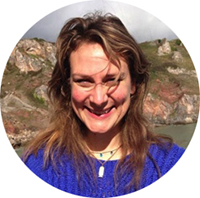The countryside is in my lifeblood. I was born and bred in it, and lived all – bar three years at university – in it. I’ve worked on farms, in nurseries and orchards, and ran a nature reserve.
If I were a British wild animal, I would obviously need to be a butterfly for a few days – a male Purple Emperor. But I’d like to be a wild cat or a stoat, too.
If you can get away from traffic, and intensive farming and forestry, then nature absorbs you. I have secret hideaways, great and small, dotted about all over the UK. All are tranquil places.
Arnside Knott, and the other carboniferous limestone hills of south Cumbria, are probably the best places in Britain to watch butterflies. But there are a great many butterfly heartlands, as described and eulogised in my book.
I am gloriously and wildly optimistic about the future of Britain’s wildlife. Because nature is so dynamic and exploitative, it has wondrous powers – not so much of recovery or restoration, but of wild transformation. Also, I think it helps that I am not an atheist, but a Christian affiliated to the great church of the outdoors: the Church of the Holy Spirit in Nature, which hasn’t been founded yet.
My favourite memory of the countryside is the long hot summer of 1976, and other great summers like those of 1989, 1996, 2006 and 2013. Summer is where we belong.
Agricultural intensification, the non-summer of 2012, and the loss of giant sentinel elms to Dutch elm disease are the worst things I’ve experienced in the great outdoors in Britain.
If I had a magic wand, the thing I would change about Britain’s countryside is, of course, farming. The models are there – each county has at least two or three brilliant wildlife-friendly farmers, often landed gentry caring for huge estates. But their work largely goes unrecognised. Yet they are visionaries, and deserve our full support.
We need a revolution in forestry, moving away from extensive plantation forestry (which diseases, fungal infestations and ‘pest’ outbreaks will sort anyway) and ridding our woods of non-native conifers (by 2020). And people need access to our woodlands, which was not afforded to them by the Countryside & Rights of Way Act (2001).
Above all, people (more than places) need rewilding – starting with childhood.
We all have different heroes at different times of our lives, people who lived lives we would have liked to have lived. BB (Denys Watkins-Pitchford) influenced me hugely in boyhood, Thoreau inspired me as a teenager, both are quoted in my book. But, live the dream: be your best self.
I am not greatly inspired by today’s environmental chief execs, or by TV wildlife presenters. I respect some, and admire people like George Monbiot who can visualise how our countryside could look. Too many people say they like the countryside as it is, because they cannot imagine how utterly amazing it could and should be.
Today’s sunset, tomorrow’s dawn and spring are the most beautiful sights in Britain.
Our countryside has inspired so much, including great children’s literature and today’s amazing new nature writing. The latter is on a high, as illustrated by the success of H Is for Hawk, but I worry about the paucity of contemporary countryside and nature-inspired children’s literature. What are today’s children reading? What’s firing them up?
To me, the greatest countryside writing is by Edward Thomas, both in his poetry and his rural prose; also his mentors, Richard Jefferies and WH Hudson. Sadly, these three tell of an idyll long gone.
Matthew Oates is an author and butterfly expert. In Pursuit of Butterflies: A 50-Year Affair (Bloomsbury Natural History, £18.99) is out now.

